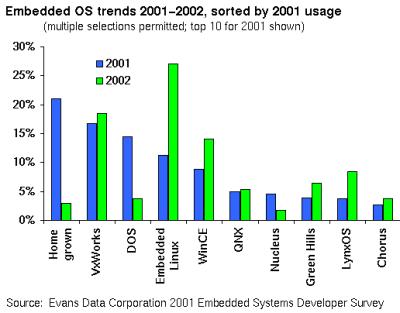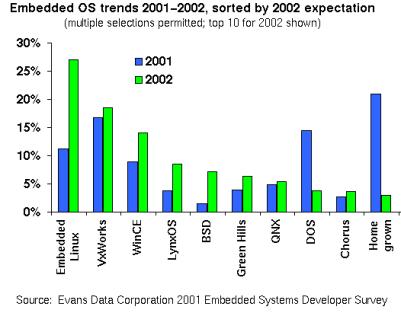Embedded Linux tops developers’ 2002 wishlist
Aug 17, 2001 — by Rick Lehrbaum — from the LinuxDevices Archive — 1 viewsEmbedded Linux is currently the third most popular embedded operating system — behind Wind River's VxWorks and Microsoft's MS-DOS — and may leap-frog into the #1 position as soon as next year, according to a new report on embedded software trends published last month by software market analyst Evans Data Corporation. The survey of over 500 embedded system developers covers embedded operating systems, databases, development tools, hardware platforms, and system development issues.
Current usage
Including “home grown” software — which still accounts for more than half of all embedded operating systems (OSes) and kernels — as a category, the top 10 embedded OSes being used in current projects (ordered by usage) are . . .
- Home grown OSes and kernels
- Wind River OSes (VxWorks and VxWorks AE)
- DOS
- Embedded Linux
- Microsoft Windows CE
- QNX
- ATI Nucleus
- Green Hills OSes (ThreadX and Integrity)
- LynuxWorks LynxOS
- Sun Microsystems Chorus

Expected usage next year
One of the most striking results of the survey is the indication of a dramatic shift away from “home grown” OSes, which have traditionally accounted for between half and two-thirds of all embedded systems' OSes. The roll-your-own category practically vanishes in a single year, with much of the slack taken up by Embedded Linux, which grows by over 140% to jump past embedded software market leader Wind River in market share.
Based on the collected data, the top 10 embedded OSes a year from now (ordered by usage) would be . . .
- Embedded Linux
- Wind River
- Windows CE
- LynxOS
- BSD
- Green Hills
- QNX
- DOS
- Chorus
- “Home grown”

The sample — embedded system developers
To obtain data for the report, Evans Data Corporation interviewed over 500 developers actively working with embedded systems. Roughly 85% of the developers interviewed were located in North America.
The developer sample was taken from a combination of lists. The phone list was based on qualified readers of EE Product News. Numbers were randomly drawn from the list and interviewers called enough to complete a target of roughly 100 developers. The remainder of the completed surveys were conducted online.
Developers from related opt-in lists were contacted via email and asked to go to a private location online and fill out the survey.
Opt-in email lists used to recruit developers included those from RTC Group, Electronic Design News, and Electronics Design. In addition an ad banner at Circuit Cellar was also used to recruit a limited number of developers.
Motivators were the ability to influence major tools makers and entry into a contest to win $500 cash.
This article was originally published on LinuxDevices.com and has been donated to the open source community by QuinStreet Inc. Please visit LinuxToday.com for up-to-date news and articles about Linux and open source.